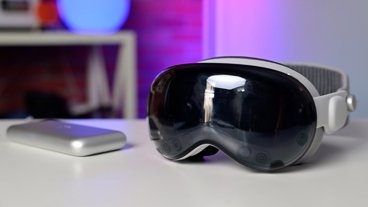The Apple versus Microsoft hardware double-standard rears up again with the latest Surface update
Across the last couple years, Apple's new Macs have been roundly criticized for raising their prices using flashy — rather than purely utilitarian— new features like the Touch Bar, while delivering only incremental improvements in performance due to a reliance on Intel's processors. Yet when Microsoft follows the same playbook, suddenly high prices are reasonable, flashy but unnecessary features are a sign of innovation, and big performance gains aren't really necessary.
This week, Microsoft bumped up the specs of its Surface Studio 2, its all-in-one PC that converts into a huge stationary tablet. It's been two years since the original revision shipped.
In the fashion of Apple, Microsoft boasted that the new machine was the "fastest Surface ever," as if it were competing against others making inferior Surface models, or that it needed to reassure the tech media that new computers are not suddenly getting slower each year after forty years.
Microsoft couldn't claim it is the fastest Windows PC, however. In fact, writing for PC World, Mark Hachman noted in his hands on, titled "Microsoft Surface Studio 2: Still the PC you desire but can't afford," that even calling it the fastest Surface "may be true in the end, though Microsoft barely squeaks by with that definition on paper."
PC nostalgia for yesterday's Mac
Microsoft will use Intel's seventh generation Core i7 chip, just like Apple's fastest standard iMac introduced in mid-2017. But rather than complaining that Microsoft's brand new Surface Studio 2 should be using Intel's latest available processor, Hachman stated, "fortunately, performance isn't why you'll buy the Microsoft Surface Studio 2: It's that amazing, vibrant display."
That's right: after decades of chiding Apple for not building a "headless" PC box from the '90s, suddenly the reason "you'll buy the Microsoft Surface Studio 2" — and don't worry, you actually won't — is because it incorporates a nice display.
Specifically, as Hachman detailed, a "4500x3000 28-inch RealSense display [that] puts out even more light than before— over 500 nits!" He added that "it was like falling into a more vibrant, colorful world."
Alternatively, you might say it's like walking into the summer of 2017, when Apple released its 5K iMac with 500 nits of brightness at 5128 by 2880 — higher than the Surface Studio 2. Plus, that iMac display is in a more media-creative friendly 16:9 aspect ratio.
To speak of this stuff as being "more than ever before" and a new epoch of computing is just kind of nutty.
What the people want
The Studio does offer its novel "easel mode" that turns its display into a panel you can write on using a special stylus, effectively making it a larger version of an iPad Pro without the mobility. If it were indeed 2015, we wouldn't have any proof whether people preferred using the conventional workstation format of the 5K iMac; the then-new, ultra-mobile iPad Pro with its Pencil for direct annotations, or the in-between Surface Studio hybrid that Microsoft shipped a year later at the end of 2016.
Nearly two years later however, we know unequivocally that the 5K iMac is a hit ultimately contributing to Apple releasing an ultra-premium, super beefy version called iMac Pro. Plus, the iPad Pro has been the most successful premium tablet by a huge margin, while Surface Studio has been little more than concept so ineffectual that it has had no discernible impact on the number of Surface devices Microsoft has been selling since its arrival.
Sales of the Surface haven't grown out of the range they've been stuck in for years.
Despite being a moderate upgrade that has only "finally" arrived after two years of the original Surface Studio, Tom Warren of the Verge wrote that "Microsoft has strangely decided to stick with a 7th Generation Intel Core i7 processor," and that "Microsoft isn't revealing exactly when this new Surface Studio 2 will launch." The expectation is that Surface Studio 2 will ship in December when Nvidia can deliver the faster GPU it uses.
Microsoft has priced the Surface Studio 2 at a very high tier — it starts at $3,500, with nothing underneath it in the Surface lineup apart from its three mobile products. That's $200 more than Apple's 27 inch iMac upgraded to a Core i7, 16GB of DDR4 RAM and 1TB of SDD storage at Apple's premium prices.
Apple is known — and often reviled by PC fans — for its premium pricing. Yet in this case, an iMac is not just cheaper when similarly configured, but offers a wide range of significantly lower priced options starting at $1,800 for the 5K iMac, or $1,100 for the smaller 4K model where Microsoft does not.
That indicates that Microsoft doesn't expect to sell many Studio 2 units to buyers outside of a very small group that will pay whatever it asks.
So talking about Surface as being "what the people want" is not only factually false, but just plain insane. The only place where Surface has ever been popular is in the minds of PC columnists and fans with only imaginary funds to buy the products.
Saying Surface is popular is like saying Google's Pixel 2 is popular: an easily demonstrable lie. One can be a fan of either, but you can't say everyone else is, because there aren't enough sales to matter.
Surface Studio 2: a product for creative pros that's not very pro
The primary allure to Studio 2 is the way it lies not quite flat so you can draw on the screen. This could appeal to a small sector of artists who prefer to draw by hand on a computer display, but prefer to be limited to a desk. Essentially, a $2,500 Wacom Cintiq permanently attached to a $1,000 PC so you throw both out and buy a pair of new ones when you upgrade.
By entering a small market with an expensive, over-serving product that's less flexible and offers nothing really new, Microsoft has capitalized on the opposite of disruption.
That is entirely the opposite of what Apple is doing with its iPad Pro, a product that makes hand-drawn artwork on a high-end display affordable, highly mobile, and compatible with a broad portfolio of popular touch-centric software, rather than trying to graft Apple Pencil into the existing desktop world of windows and a mouse, and requiring a complex hinge to make it possible to turn a desktop PC into a tilted drawing surface.
Really, the meat of Microsoft's Surface show was so thin that Warren asked Microsoft's Surface chief Panos Panay what else the company might do, suggesting exciting ideas like a USB-C webcam or a modular version of the Surface Studio that would allow users to upgrade its internals.
Panay replied, "Probably, you look at it and you see what's the evolution and how do we make it better for our customers. Yeah, there's still so much more to do, and while I won't tell you what it is you can put stories together."
If you wonder why Apple doesn't comment on future products, you might also wonder why Microsoft does, actively suggesting here that consumers wait for an upgradable version in the pipeline and encouraging the Verge to imagine up vaporware, which it promptly did.
The problem is, imagined vaporware is no longer a functional way for Microsoft to compete against the better, real products of its competitors. This may have worked in the '90s, when its arrogant promises were frequently used to dampen interest in real, shipping products, but leaving the tech press to imagine how great Vista could be while Apple was delivering real updates for Macs didn't work out well.
Imagining up a fantastic future for Zune, Windows Phone, Windows RT, and Microsoft Band didn't help Microsoft compete against iPod, iPhone, iPad and Apple Watch, either.
Higher entry price, fewer options, seldom updated: why can't Apple do this?
Rather than chiding Microsoft for doing all the things they've badgered Apple about since the beginning of time, PC pundits have a whole new way of looking at the world once it's a place where it's Microsoft trying to make money rather than Apple. And yes, it's a lot like their reception of Google's premium-priced hardware boondoggles like the Chromebook Pixel.
Writing for the infamous ZD Net, Adrian Kingsley-Hughes coughed up a word salad on Microsoft's Surface announcement titled, "Microsoft's new Surface PCs are the Macs I want Apple to make."
The only way to interpret this into a coherent thought is to assume he means Apple should offer products nobody wants and then go out of business, because he has never written anything in his career to suggest otherwise. But what he says he means is that, after switching "from PCs to Macs a few years ago as my daily workhorses" he now wants Apple to "learn a thing or two from what the Redmond giant is offering its users."
He called Apple "old and stale" multiple times in a single page.
"While Apple has been neglecting its desktops and laptops to mercilessly push the iPhone, Microsoft has been busy reinventing the PC," he wrote. "And the result is that Mac sales have become mediocre at best." Those last few words hyperlinked to an article he wrote in Q3 2014 referencing 18 percent YoY growth to 4.4 million Mac sales, a number he indeed did call "mediocre" at the time. But words have meanings.
Microsoft has never sold so many Surface PCs in a year, and its sales haven't really grown since it launched the Surface idea, so it's not really clear what he's trying to say in calling Apple's vastly larger Mac business "mediocre at best." But the words he uses are that "Apple is in a position where it can let the Mac line go old and stale because Apple isn't a computer company anymore. It's now a company that sells the iPhone."
In reality, the fact is that Apple's Mac operations have generated $25.2 billion in revenues over the last four quarters. Microsoft's total Surface revenues over the same period were $4.7 billion. Of course, most of that was from sales of its hybrid tablets, more comparable to Apple's iPad business which itself generated another $19.5 billion.
To suggest that Apple doesn't care about Macs because it has a much larger business in phones is pretty silly coming from a person who is certainly aware that Surface isn't Microsoft's profit center.
Additionally, Microsoft is doing a lot of work to support Surface and its four lines of hardware. Yet at the volumes of units it's selling, it can't possibly be making sustainable profits. Apple's computing product lineup isn't vastly larger, but its sales are massive and global. That enables it to make far greater profits even with pricing lower than Microsoft's.
Microsoft is learning from Apple, just not quickly enough to matter
It is true that Microsoft totally dropped the ball with Windows Phone and Nokia, leaving it with no meaningful remaining phone business at all. But that doesn't mean Microsoft cares more about its Surface PC hardware than Apple cares about its Macs.
The ZDNet article immediately contradicts itself, stating that Macs are indeed critical to Apple because "having devices that support the iPhone and iPad is still important because it keeps people in the ecosystem. If there are no new Macs, people will start to look elsewhere, and that weakens Apple's grip on users."
Maybe he just thinks he's the only one who thought of this, and Apple is ready to throw away the Mac even as it invests so much effort into its Continuity technology— and most recently, its efforts in macOS Mojave to make iOS UIKit apps work on the Mac.
In fact, since Microsoft shipped Windows 10 back in 2015, it has only deployed five minor point updates to its PC users. Across that time, Apple delivered macOS El Capitan followed by six point updates, macOS Sierra followed by six point updates, macOS High Sierra with six point updates, and the most recent macOS Mojave. A reasonable person wouldn't conclude that Apple doesn't care about the Mac because its iPhone business is doing so well in parallel (and getting the same pace of iOS updates).
One paragraph later in the piece, and the author's certainty that Apple doesn't care about Macs anymore has turned into a future possibility: "But if Apple has dropped the ball, and can't keep the Mac offering updated, it seems that Microsoft, along with its army of OEMs, is ready to fill the void."
However, given that Mac sales are incrementally growing even as PC sales shrink globally, and that Apple's iPad is a central cause of PC's arrested growth, isn't it Microsoft that dropped the ball, along with its army of OEMs, and hasn't Apple already "filled the void," leaving little room for premium PC makers, including Microsoft, to make any gains?
Apple is trying new things, they're just successful
While Apple hasn't radically remixed its hit form factors, the company also isn't just conservatively selling slightly polished versions of yesterday's technology. Its iPads and Macs employ new innovations ranging from custom high performance SSD controllers to advanced displays with ambient-aware color management.
Apple pulled off porting its desktop OS to mobile, lightweight ARM hardware two years before Microsoft and managed to profitably sustain its iPad business across the five years since Microsoft gave up on RT, without destroying its conventional Mac business.
Yet outside the largely standardized form factors of mobile, laptop and desktop computing, there's something else that Apple is experimenting in that is wildly more successful than anything Microsoft has done with its Surface brand.
This performance is hidden inside Apple's Other Hardware segment, which includes HomePod, Apple TV, Apple Watch, AirPods and Beats. These specialized computers that drive personal entertainment, home audio and wearable technology have excelled in markets that other PC and mobile vendors (inclining Microsoft, Google and Samsung) have failed miserably.
Apple's sales of Other Hardware have absolutely skyrocketed over the past four years, growing from $8.2 billion in 2014 to $14.3 billion last year. Over the last four and a half years, Apple's Other Hardware has sold $52.7 billion worth of "less conventional computing." That alone is three times the revenues of Microsoft's entire Surface business over the same period.
 Daniel Eran Dilger
Daniel Eran Dilger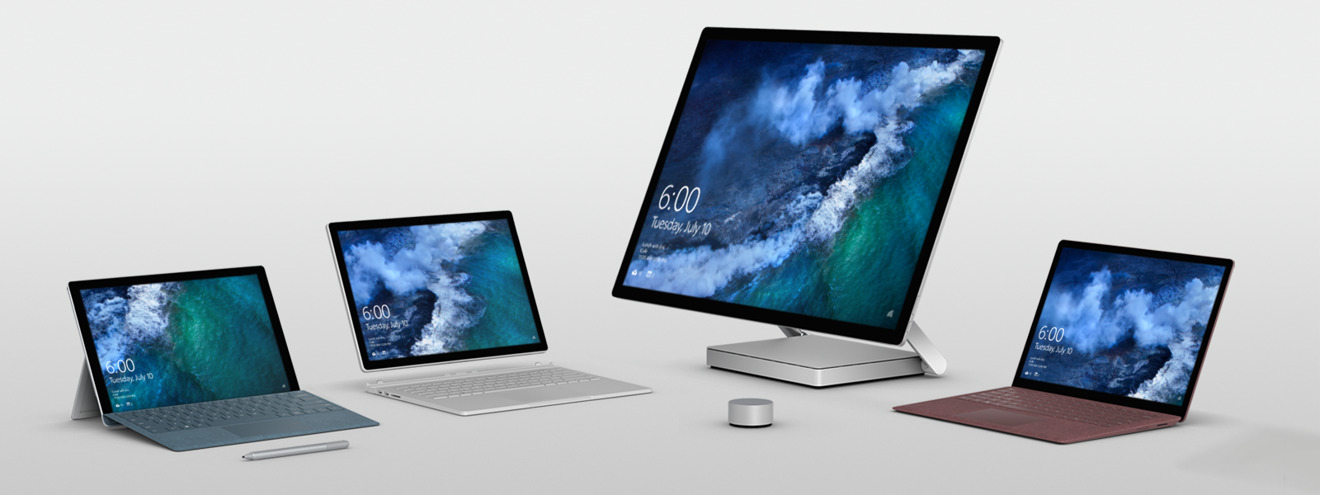
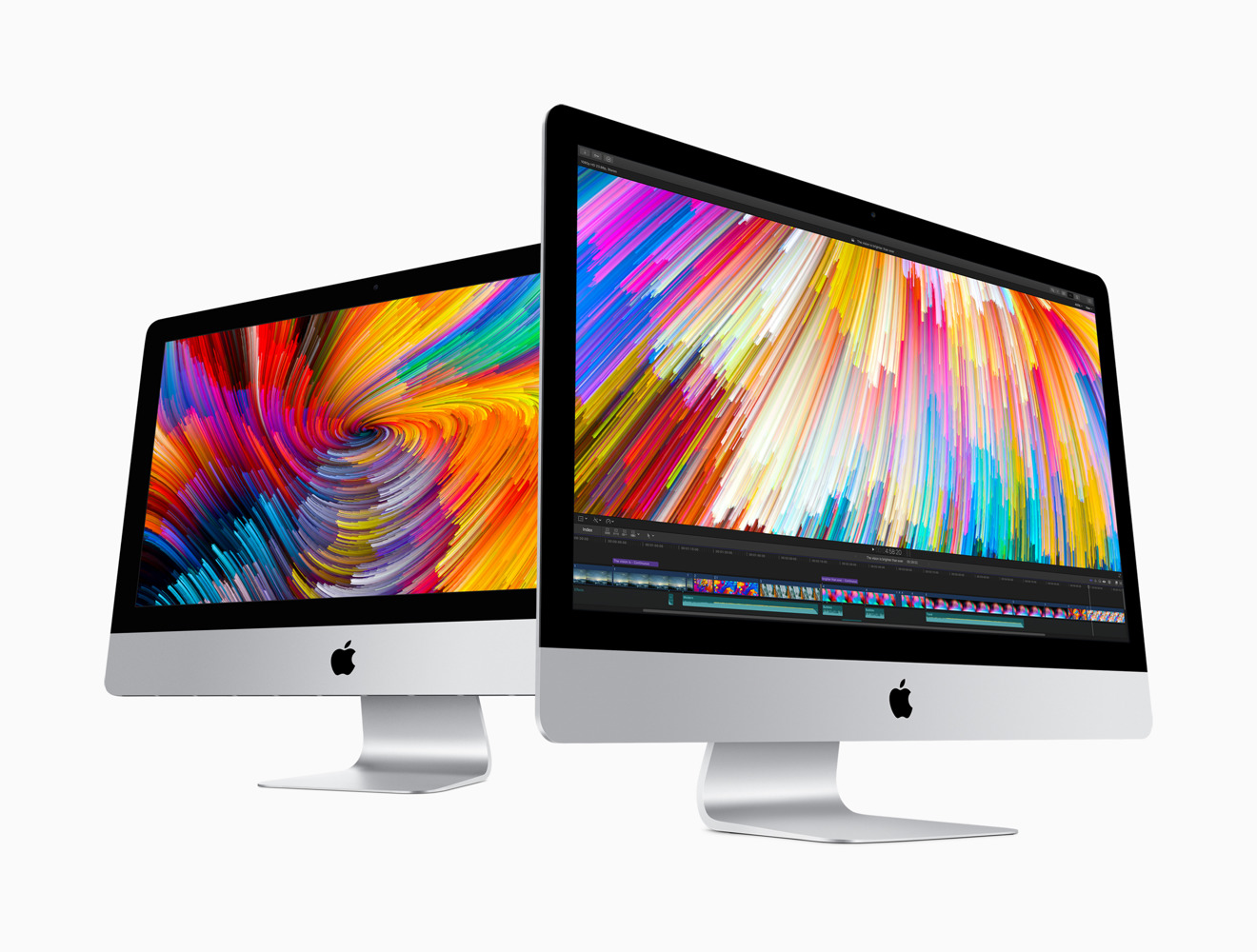
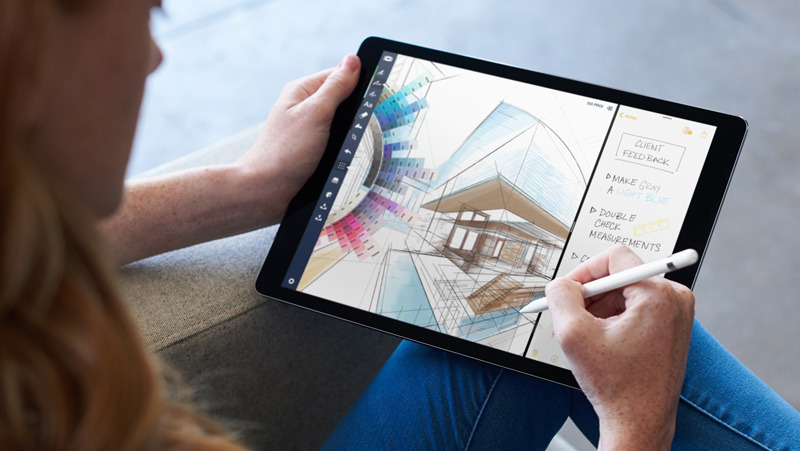
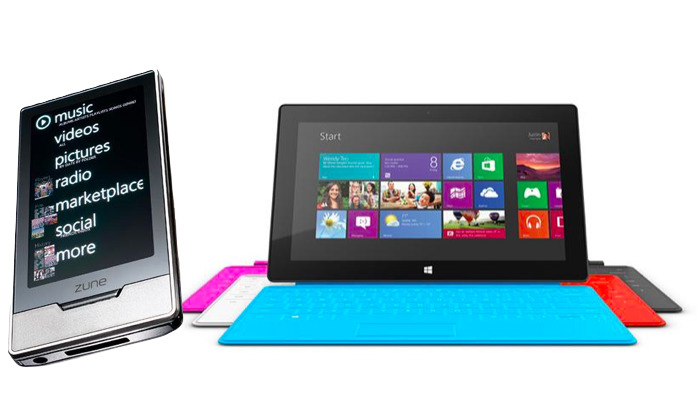
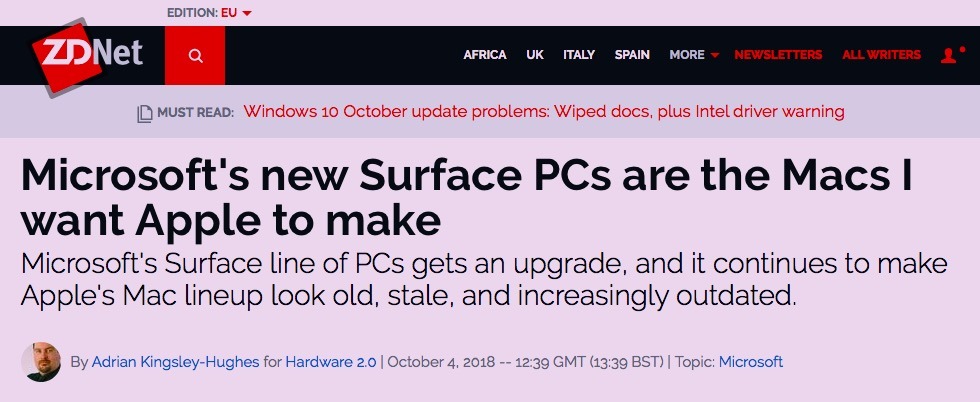
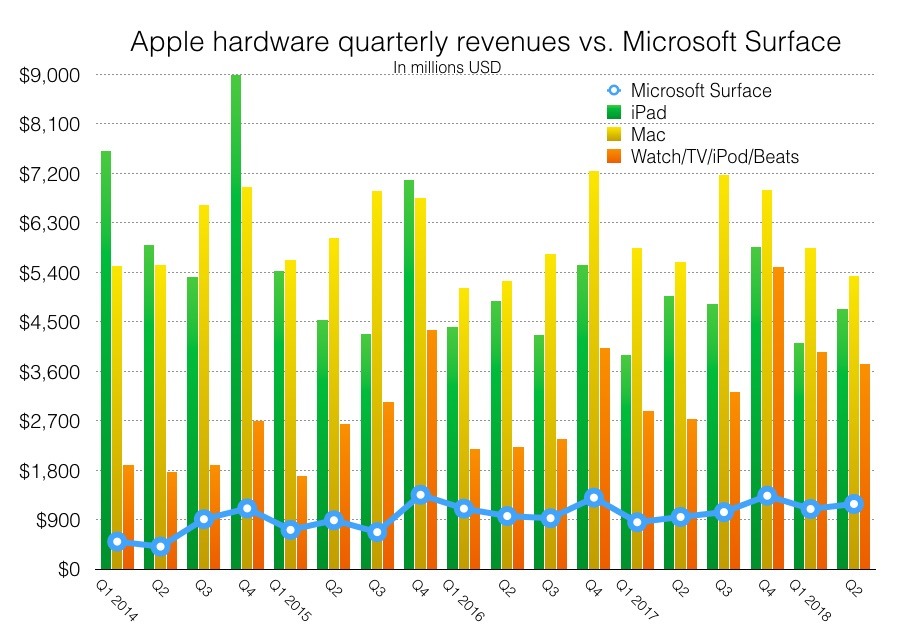
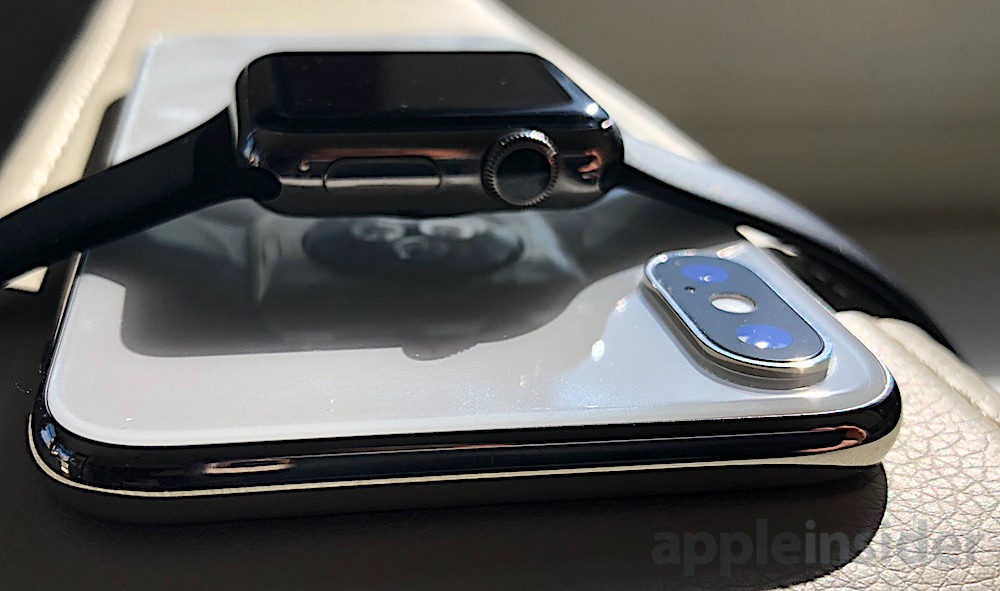











 David Schloss
David Schloss
 Marko Zivkovic
Marko Zivkovic
 Malcolm Owen
Malcolm Owen

 William Gallagher
William Gallagher
 Mike Wuerthele
Mike Wuerthele
 Christine McKee
Christine McKee


